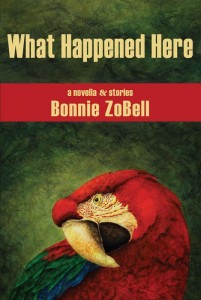Book Review
 The title of Bonnie ZoBell’s short fiction collection, What Happened Here, is the best kind of title: It is fresh and tonal, broadcasting information intuitively, before the front cover has even been lifted. It has a voice that promises an emotional reward and an expanded awareness in the reading, and it is this promise that drives readers into the book. The title both asks a question, and tells us that the stories that follow will answer it. As we read on, we discover the stories ask additional questions of their own, and reveal their answers in unexpected ways.
The title of Bonnie ZoBell’s short fiction collection, What Happened Here, is the best kind of title: It is fresh and tonal, broadcasting information intuitively, before the front cover has even been lifted. It has a voice that promises an emotional reward and an expanded awareness in the reading, and it is this promise that drives readers into the book. The title both asks a question, and tells us that the stories that follow will answer it. As we read on, we discover the stories ask additional questions of their own, and reveal their answers in unexpected ways.
The titular event is the 1978 Pacific Southwest Airline crash, thirty years before the start of the book, in San Diego’s North Park neighborhood, in which all of ZoBell’s protagonists live. The crash killed all 137 people onboard, and 7 people on the ground, bringing the death toll to 144 and making it the deadliest aircraft disaster in California’s history. The protagonists all carry ghosts from their pasts. Some are unable to escape dark shadows from their childhoods; others feel besieged in interpersonal relationships troubled by mental and physical illness and professional failure. The crash, which both precedes all the stories’ events and comes first in the collection, amplifies these preexisting hauntings. What unites these characters is the presence of what ZoBell at one point calls “the black monster,” which we recognize inside each of us: the struggle to understand ourselves and the choices we make, and how our understanding changes us, or doesn’t.
The opening novella, which introduces all the characters in the eleven stories that follow, uses the airline accident as a backdrop against which the main storyline unfolds—a woman, Lenore, fights to keep her clinically depressed husband, John, from descending into madness, as she watches a similarly ill neighbor, Archie, plan a gathering in observation of the thirtieth anniversary of the plane crash. As the novella ends, we see, in Lenore’s reflections, what will arise in the remainder of the stories: strange, eerie obsessions and ambitions that are both compelling and repellent to those who possess them, exactly like the photographs of the destroyed homes and mangled body parts from the crash site that Archie displays at the anniversary gathering.
Driving the stories is ZoBell’s sure-handed and emotionally intelligent prose. We feel more than see the layers of construction gradually build, sentence by sentence, page by page. The result is stories that are deeply felt, whose weight is sensed, and speak volumes beyond what is actually written on the page. ZoBell’s stylistic choices are strong, with each sentence a pleasure to read, each paragraph sustaining itself, a standalone that both enchants and informs, as in the following example from “Sea Life”:
Her body stiffens and her cute little lips stick out. He watches her rifle through his clothes, straightening, always straightening. At first Iylette’s pierced tongue and the two-inch plugs lodged into the lobes of her ears made her seem like a soul mate, a person who yearned for the edgy peninsula of a life, still vaguely attached to the mainland, but dexterous enough to transcend it.
When it comes to structure, ZoBell is at her best when she maximizes the use of subtext and trusts her readers to understand the implied message—the resulting understanding resonates powerfully and the moment sings, made all the stronger by subtext’s characteristic guise of effortlessness. There are occasions, however, when she falters, and the prose falls flat—too much is explained to us in a powerful moment, as if this is something we just can’t miss, and we are pulled out of the story by being made too aware of her efforts and her desire for us to understand. The magic evaporates, and we move on, trying to sink back in. These instances, though, are rare, and far more memorable are the moments that pierce through the surface unexpectedly, making us aware of the subterranean significance just beneath. This is particularly true of each story’s ending.
What Happened Here will certainly appeal to readers who remember the 1978 PSA airline crash, or those who live in San Diego, as the author does, but its real draw is the characters, moving through the wreckage, whatever that may look like, of their own lives, wondering what happened and if there’s anything left to save. Despite what it may look like, they each, somehow, find the strength to sift through, to rebuild, to embrace the wildness and beauty in what’s been broken.
About the Reviewer
Mary Medlin’s work has appeared in Colorado Review, Blackbird, and Confrontation, and was nominated for a Pushcart Prize in 2011. She is the recipient of fellowships from the MacDowell Colony and the Ucross Foundation. She holds an MFA from Warren Wilson College and lives in Cambridge, Massachusetts.